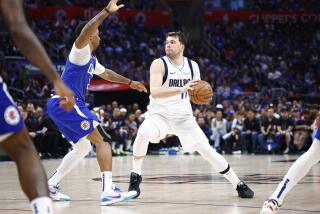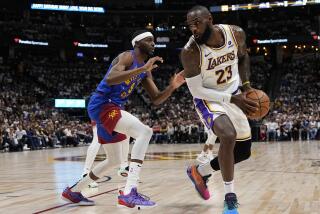TV Likes the Numbers Its Top Rebounder Gets : Despite Their Resurgence, NBA Ratings Continue to Trail College Basketball’s
- Share via
Just when the advertisers thought it was safe to go back into the NBA, along comes the Boston-Houston championship series, which has resembled a dummy scrimmage. Either the Rockets must start showing something or it’s going to be click-off city and the start of the summer viewing season, for real.
But for the NBA, it’s already been a season to remember. At worst, it has made an impressive TV rally: regular-season ratings up 11% over last season, which was up 2% over the one before; playoff ratings, going into the final, up 18%.
It’s time for interested parties to start crowing in earnest. Allowing for the inevitable degree of self-congratulation, here goes.
From Neal Pilson, head of CBS Sports, which carries NBA games:
“It didn’t just happen and it wasn’t just CBS. The league itself has made a lot of important innovations. It addressed the drug problem earlier than any professional league. It addressed the salary instabilities with the salary cap.
“There is a sense with the NBA that the players, owners and the league are together in terms of putting up a positive image. You don’t necessarily have that sense with some other professional leagues. I think the players’ union in the NBA has identified itself with the success of the league, rather than the success of the union. I don’t want to get into a long argument about any other league.
“It has been a modern success story, with the league, the owners, the players and CBS having had input.”
The future doesn’t look bad, either. A number of young stars--Michael Jordan, Akeem Olajuwon, Charles Barkley, Dominique Wilkins--were pushed to the forefront this spring and found ready to join the standbys, Larry Bird and Magic Johnson. Not to mention the oldest stand-by of them all, Kareem Abdul-Jabbar, whose level of performance has remained so high for so long that his once-surly persona has worn off, both in fact and in public perception.
Then there are the New York Knicks, an X factor of mammoth potential.
Fifteen years ago, when the NBA was calling itself the sport of the 1970s, it can be argued that it was merely riding the coattails of the Knicks, twice champion and once runner-up in 1970-73.
The Knicks owned Gotham. Before Jack Nicholson’s shades started irritating those in the American heartland, back when he was making biker movies, Madison Square Garden attracted Woody (Allen), Dusty (Hoffman) and the crowd from Elaine’s, as well as a few thousand trend-crazed pre-Yuppies from Madison Avenue and the network home offices.
It can also be argued that the NBA’s mid-’70s slump reflected the Knicks’ demise. The NBA has made its recent TV leap with little help from New York, which is busy following Dwight Gooden and George Steinbrenner’s latest change of pitching coaches. But even the lowly Knicks have Patrick Ewing, another high draft pick this season, and every expectation of moving up.
Boston Globe TV critic Jack Craig said: “New York, for the first two games of the finals, has had the smallest viewing audience of the top 12 markets: a 5.5 Monday afternoon (for Game 1), an 8.7 Thursday night (Game 2). That’s in America’s so-called basketball hotbed. That would tend to undermine the argument that New York is all-important.
“You’re only talking about 2.4% of the country in New York. Of course, the network people are there. Stories go out on the wire services from there. It has been argued that the downfall of the Jets and Giants in football were very harmful to the NFL and that as both of those teams have come back, the ratings have gone up. Baseball on Saturday afternoons tries very hard to show one of the New York teams, or the Dodgers, or the Angels.”
In TV terms, of course, there is nothing to compare with the NFL, which is to say the Super Bowl, and baseball, which is to say the World Series.
Pilson said: “The average Super Bowl rating is a 49. That means half of the country watches the Super Bowl. The highest-rated World Series was in 1976 (Cincinnati Reds-Boston Red Sox). I think it was 35-38, something like that. The highest-rated basketball game was the Indiana State-Michigan State NCAA final in 1979. It was a 24. Frankly, the highest-rated NBA final game (the 1984 Laker-Celtic seventh game) was a 19.”
The great plums, the network contracts, seem to follow single-event ratings. The NFL’s old contract was $2 billion for five years with the three networks. Baseball is in the middle of a $1.1-billion contract for six years with two networks.
The NBA? It just signed for $43 million a year with CBS and was overjoyed to get it. It also gets $25 million a year from Ted Turner’s Atlanta superstation, WTBS, the league’s cable outlet.
The NBA doesn’t even dominate television basketball viewing. There is great excitement when it moves ahead of the colleges in regular-season ratings, but the NCAA tournament is still unchallenged.
The tournament has the built-in advantage of single-elimination, so that every game is the equivalent of a Game 7. The NBA has multi-million dollar payrolls to meet and needs a lot of openings to grind its way back to break even.
The top 13 TV basketball audiences of all-time have all been for NCAA finals. You have to drop to No. 14 for the highest-rated pro game, that Lakers-Celtics seventh game in ’84.
Consequently, college basketball is red-hot. For just the tournament, CBS pays the NCAA $30 million a year. CBS last season carried 19 games. The ones it had no interest in were then sold off to ESPN.
Greater payoffs beckon. NBC is pleading for a baseball-like plan, where two networks rotate the championship event. CBS officials say the tournament is perfect as is.
CBS, NBC and the cables also make separate deals with the various conferences and schools for regular-season games. Even ABC in its new cost-conscious Capital Cities era, is about to announce its own package. ABC, of course, is frozen out of the NCAA tourney, and beyond the network and cable competition, there are 1,001 syndicators out there to contend with.
But, says the new head of ABC Sports, Dennis Swanson: “We thought it was important to have a presence in basketball.”
But in TV, movement is everything and the NBA is moving. Why?
--College overexposure. The NCAA has put out a huge crop of great stars since 1979, starting with Bird and Magic, continuing through Ralph Sampson, Ewing, Olajuwon, Jordan, etc. The colleges are too exposed for their own good, but that’s their problem. As far as the NBA goes, it just makes each college game that much less important, while making the incoming college players that much more identifiable.
Says the Globe’s Craig: “The (New England) Patriots just drafted a running back out of SMU (Reggie Dupard) who’s supposed to be the greatest thing since Eric Dickerson. And nobody here has ever heard of him. That doesn’t happen in basketball.”
--White stars. There is little question among Boston writers that the accomplishments of Bird, Kevin McHale, et. al., have had tremendous impact among white viewers. This means little if you believe that Boston is atypically racist, which the Boston writers do not. Otherwise, there is the possibility that the success of the white players has had impact elsewhere, too.
Craig said: “Of course, I’m a little bit close to the situation, but I think Larry Bird means a lot and you can’t underestimate that fact that he’s white. He seems to be reaching a position of idolatry in the heart of TV that I’m not sure anyone else is today. He’s a fine player and he has a certain tough stance. CBS just brought Magic Johnson in here and he was wonderful. He has that wonderful smile, but he’s a black man.
“I’ll give you an example. I just got a call from CBS about their next halftime feature. They were going to do Robert Reid, the minister-player. They’ve just decided to tear it up and do the life and times of Larry Bird, the basketball player as seen through his own eyes. He seems to be becoming the focus. Then he plays well and well and they want to do more on him.”
--Technical adjustments. The NBA tries to get its season in between the end of the World Series in October and the All-Star game in July.
Baseball, however, is not the key factor in moving the NBA season back in time. It’s the TV sweeps rating period in May, which used to coincide with the NBA finals and resulted in their exclusion from prime time.
This cost the NBA some of its finest moments. Remember rookie Magic Johnson’s title-winning 42-point game at center in 1980 against the 76ers? It was shown live in Los Angeles, where it drew a 20.9 rating, but taped and aired late at night everywhere else. The overall rating was 8.7.
The NBA once winced at gibes that its season ran too late, but no longer. Who cares if all the white players have suntans and the Stanley Cup was decided three weeks before? Has anyone without a cable hookup seen a playoff hockey game in this decade?
This NBA season could run to June 11. Next season, the league is moving the schedule back another three or four days. It has another three weeks it can play with in future years before it hits the All-Star game.
--Strategic withdrawals. CBS took over the NBA from ABC in 1973-74, the season after the Knicks’ last title. It drew an 8.6 rating for the regular season its first time out and hasn’t been that high since. This season’s rally takes it only back as far as 7.1.
CBS used to show 20 regular-season games. Since 1982, it has cut back to a handful, on special occasions such as Christmas or the open week before the Super Bowl, and matchups involving the glamour teams from Boston, Los Angeles, New York and Philadelphia. It has worked. The Knicks’ upset of the Celtics last Christmas drew a 10.0.
Profitability--Ratings notwithstanding, you can make money with the NBA.
The riches networks once lavished for big-ticket items like the NFL were hard to recoup. They were traditionally regarded as loss leaders that made up the difference in promotion and prestige. The rationale no longer holds, probably because of bottom-line concerns following the takeover of ABC and Ted Turner’s bid to annex CBS.
Pilson said: “What is ironic is that we lost money with pro football last year and we made money with basketball, pro and college. Figure that out.
He added sardonically: “It might have to do with rights fees.”
A CBS official quotes ABC’s Swanson as having said he can hardly wait until 1990, so he can get out of his half-billion-dollar share of the baseball contract.
The NBA, once left in the bidding backwash, finds itself today reasonably priced. A little bargain at $43 million.
TV’s All-Time Top-Rated Basketball Games
Teams Year Event Rating 1. Michigan State-Indiana State 1979 NCAA Final 24.1 2. Villanova-Georgetown 1985 NCAA Final 23.3 3. N.C. State-Houston 1983 NCAA Final 22.3 4. North Carolina-Georgetown 1982 NCAA Final 21.6 5. UCLA-Kentucky 1975 NCAA Final 21.3 6. Indiana-North Carolina 1981 NCAA Final 20.7 7. Louisville-Duke 1986 NCAA Final 20.7 8. UCLA-Memphis State 1973 NCAA Final 20.5 9. Indiana-Michigan 1976 NCAA Final 20.4 10. Marquette-North Carolina 1974 NCAA Final 19.9 11. Kentucky-Duke 1978 NCAA Final 19.9 12. Louisville-UCLA 1980 NCAA Final 19.8 13. Georgetown-Houston 1984 NCAA Final 19.7 14. Celtics-Lakers 1984 NBA Final 19.3
More to Read
Go beyond the scoreboard
Get the latest on L.A.'s teams in the daily Sports Report newsletter.
You may occasionally receive promotional content from the Los Angeles Times.










